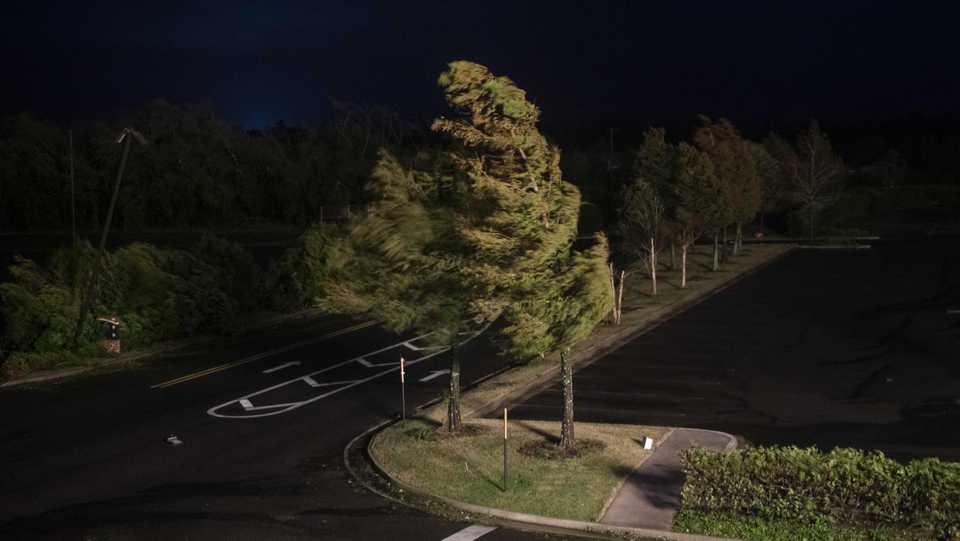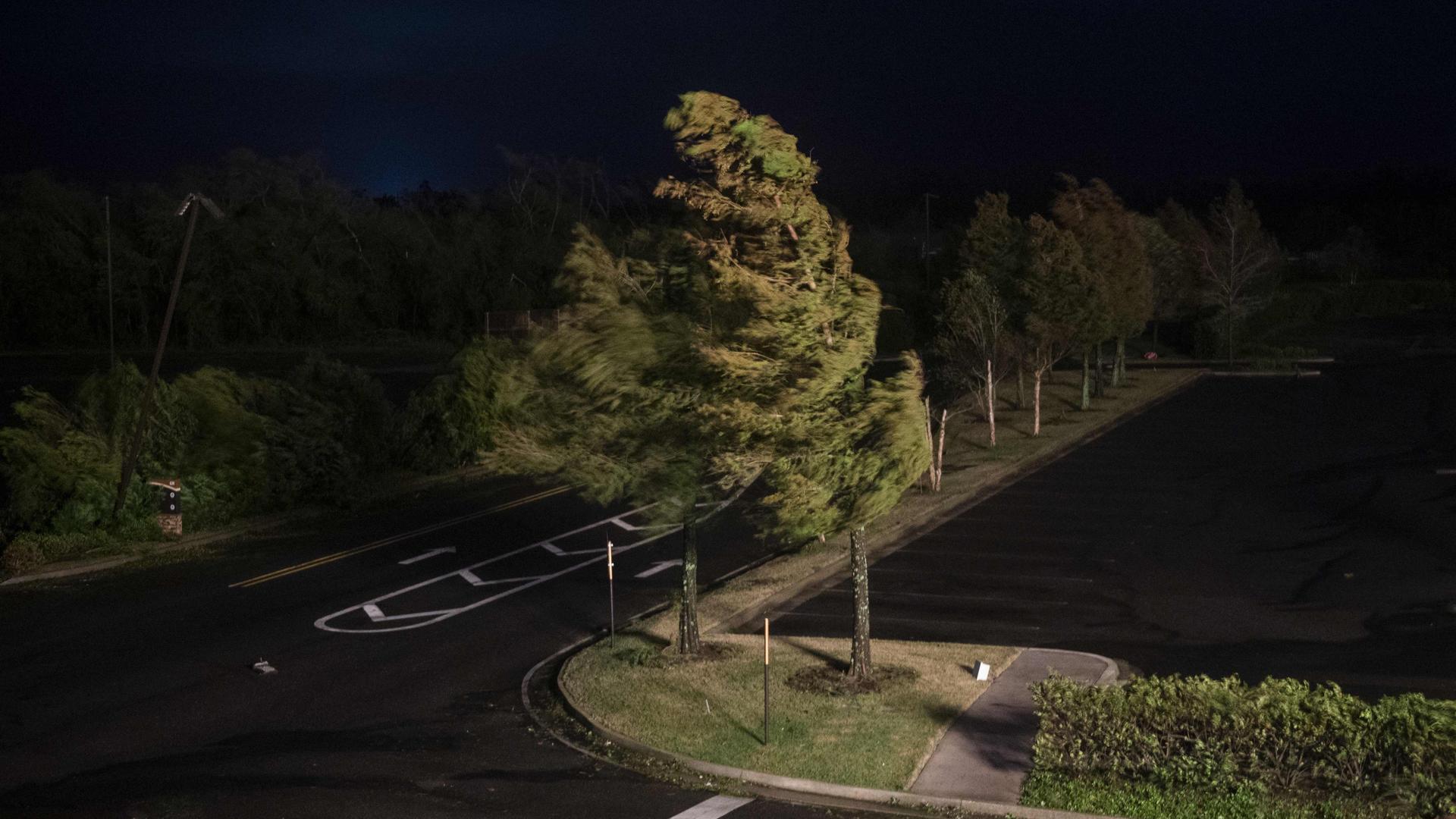
Hurricane Laura has made landfall in southwestern Louisiana as one of the most powerful storms to hit the state, with forecasters warning it could push a massive wall of water 40 miles inland from the sea.
Laura made landfall just before 1 am (local time) as a Category 4 storm packing winds of 150 mph (240 kph) in the small town of Cameron, Louisiana, the National Hurricane Center (NHC) said.
It rapidly weakened to a Category 2 storm on Thursday morning with maximum sustained winds of 105 mph (168 kmh) as it moved north and battered southwest Louisiana, a marshy region particularly prone to storm surge and flooding.
Besides threatening life, the storm was barreling toward the heart of the US oil industry, forcing oil rigs and refineries to shut down production.
Laura’s winds tore through Lake Charles, Louisiana all night, ripping roofs from buildings and shattering glass windows, videos posted to Twitter showed.
The city of 78,000 was seeing sustained winds of 85 mph (137 kph) and gusts up to 128 mph (206 kph), in the hour after landfall, the NHC said.
“This is one of the strongest storms to impact that section of coastline,” said David Roth, a forecaster with the National Weather Service.
“We worry about that storm surge going so far inland there because it’s basically all marshland north to Interstate 10. There is little to stop the water.”
“Catastrophic storm surge, extreme winds and flash flooding continues in portions of Louisiana,” the NHC said in an early Thursday bulletin.
READ MORE: Two tropical storms to hit US coast two days apart with hurricane force
At 1 am CDT, Hurricane #Laura has made landfall in southwestern Louisiana near Cameron as a category 4 #hurricane. Maximum sustained winds were 150 mph, with a minimum central pressure of 938 mb. Potentially catastrophic impacts will continue. More: https://t.co/tW4KeFW0gB pic.twitter.com/GVWRnmGejy
— National Hurricane Center (@NHC_Atlantic) August 27, 2020
‘Extremely dangerous’
The storm grew nearly 87 percent in power in just 24 hours to a size, the National Hurricane Center called “extremely dangerous.”
Drawing energy from the warm Gulf of Mexico, the system was on track to arrive early on Thursday during high tide as the most powerful hurricane to strike the US so far this year.
“It looks like it’s in full beast mode, which is not what you want to see if you’re in its way,” University of Miami hurricane researcher Brian McNoldy said.
READ MORE: Potential hurricane threat to US as twin storms approach
As #Laura roars ashore with 150 mph winds, Louisiana Gov. Edwards warns “there will be parts of Lake Charles underwater that no living human being has ever seen before” https://t.co/4d1hyefEzt pic.twitter.com/FMsQ670rwg
— Jon Passantino (@passantino) August 27, 2020
‘It’s just hard to move out’
One major Louisiana highway already had standing water as Laura’s outer bands moved ashore with tropical storm-force winds. Thousands of sandbags lined roadways in tiny Lafitte, and winds picked up as shoppers earlier on Wednesday rushed into a grocery store in low-lying Delcambre.
READ MORE: Tens of thousands flee as fires rage across California
Trent Savoie, 31, said he was staying put. “With four kids and 100 farm animals, it’s just hard to move out,” he said.
Texas Gov Greg Abbott and Louisiana Gov John Bel Edwards fretted that the dire predictions were not resonating despite authorities putting more than 500,000 coastal residents under mandatory evacuation orders.
Officials said at least 150 people refused pleas to leave and planned to weather the storm in everything from elevated homes to recreational vehicles in coastal Cameron Parish, which could be completely covered by ocean water.
“It’s a very sad situation,” said Ashley Buller, assistant director of emergency preparedness. “We did everything we could to encourage them to leave.”
Edwards activated the state’s entire National Guard. In Lake Charles, Guard members drove school buses around neighbourhoods, offering to pick up families.
Across the state line in Port Arthur, Texas, few stragglers boarded evacuation buses, and city officials announced that two C-130 transport planes offered the last chance to leave.
READ MORE: At-risk Caribbean scrambles to prepare for hurricanes during pandemic
Abbott warned that people who fail to get out of harm’s way could be cut off from help long after the storm hit.
A Category 4 hurricane can render wide areas uninhabitable for weeks or months and knock out power for just as long. The threat of such devastation posed a new disaster-relief challenge for a government already straining under the coronavirus pandemic. The parts of Louisiana that were under evacuation orders included areas turning up high rates of positive Covid-19 tests.
The National Hurricane Center kept raising its estimate of Laura’s storm surge, from 3 metres just days ago to twice that size — a height that forecasters said would be especially deadly.
By Wednesday night, Laura was churning about 145 km south of Lake Charles and moving north-northwest at 15 24 kph.
On Twitter, President Donald Trump urged coastal residents to heed officials. Hurricane warnings were issued from San Luis Pass, Texas, to Intracoastal City, Louisiana, and reached inland for 322 km. Storm surge warnings extended from Freeport, Texas, to the mouth of the Mississippi River.
For some, the decision to leave home left them with no place to stay. Wary of opening mass shelters during a pandemic, Texas officials instead put evacuees in hotels, but Austin stopped taking arrivals before dawn because officials said they ran out of rooms. Other evacuees called the state’s 211 information line and were directed to Ennis, outside Dallas, only to be told after driving hundreds of kilometres no hotels or vouchers were available.
Taniquia Ned and her sisters showed up without money to rent a room, saying the family had burned through its savings after losing jobs because of the coronavirus. “The Covid-19 is just totally wiping us out,” said Shalonda Joseph, 43, a teacher in Port Arthur.
Edwards lamented that the impending storm meant suspension of community testing for Covid-19 at a crucial time — as elementary and secondary schools in Louisiana open and students return to college campuses.
Forecasters said storm surge topped by waves could submerge entire towns. Water was already rising in the small Louisiana community of Holly Beach in the imperilled Cameron Parish.
Laura was expected to cause widespread flash flooding in states far from the coast. Flood watches were issued for much of Arkansas, and forecasters said heavy rainfall could arrive by Friday in parts of Missouri, Tennessee and Kentucky. Laura is so powerful that it’s expected to become a tropical storm again once it reaches the Atlantic Ocean, potentially threatening the Northeast.
Becky Clements, 56, evacuated from Lake Charles after hearing that it could take a direct hit. She and her family found an Airbnb hundreds of kilometres inland. Almost 15 years have passed since Hurricane Rita destroyed the city.
“The devastation afterward in our town and that whole corner of the state was just awful,” Clements recalled. “Whole communities were washed away, never to exist again.”
The church educator said she fears for her office, which is in a trailer following recent construction.
“I very much anticipate that my office will be gone when I get back.”
Price hikes
The hurricane also threatened a centre of the US energy industry as the majority of Gulf oil and natural gas production shut down. Consumers are unlikely to see big price hikes, however, because the pandemic has decimated demand for fuel.
Laura closed in on the US after killing nearly two dozen people on the island of Hispaniola, including 20 in Haiti and three in the Dominican Republic, where it knocked out power and caused intense flooding.
Laura will be the seventh named storm to strike the US this year, setting a new record for US landfalls by the end of August. The old record was six in 1886 and 1916, according to Colorado State University hurricane researcher Phil Klotzbach.










Discussion about this post